Hi Friends! This is a big topic and a very important one to me, because if you’ve been following along, you know that I think babywearing is life! For everyone involved…I love having my baby close to my chest, and I think it is so good for her growth, development, and attachment. Did I mention it also helps me get a lot of things done? And it’s a fun way to explore the world…feel free to check out Kids Who Explore for our outdoor inspiration! A few things I want to cover about me, in regards to this interview, and only take what you want from it, as every parent and baby is different – with all my research, I’ve chosen not to swaddle my babies or wear them forward facing on my chest. In this interview, Vanessa talks about the Tula Free to Grow, which has been my absolute favourite carrier! I did team up with Tula because of it, and you can use the coupon code LAURENEB5 for 5% off on their products at check out, but if you want to support local small shops, that is great too – Babes in Arms being one of my favourite in Calgary (Vanessa discusses an Edmonton shop further down). I absolutely loved getting to talk with Vanessa about babywearing, from the benefits to the how-to’s, to the things that hold parents back! She is another expert with a wealth of knowledge and I’m so grateful she took some time to chat with us today.
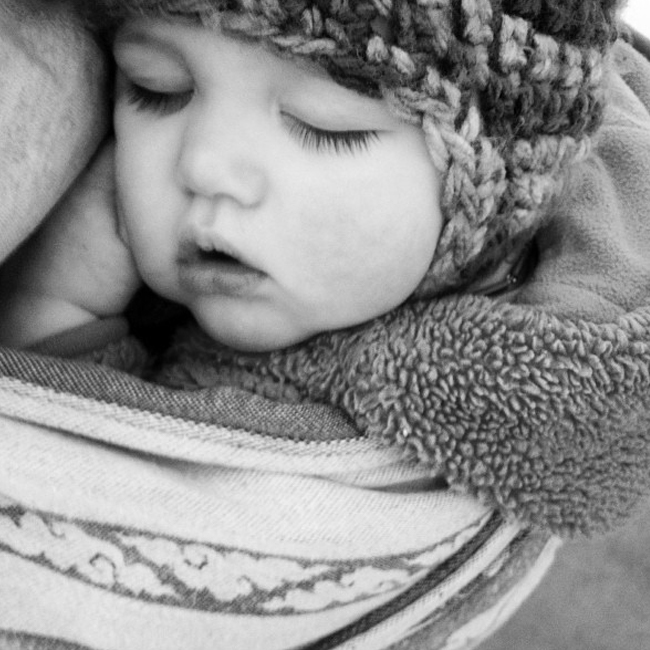
Hi Vanessa! Thank you for chatting with me! I know you wear many hats when it comes to pregnancy, birth, and postpartum. Can you tell us a little about yourself, personally and professionally?
Yes, for sure! I’m Vanessa! Born and raised in Edmonton (Sherwood Park), Alberta. I met my husband shortly after high school and we’ve been together for 15 years, married for 10, and we have 2 little kiddos – a girl who is 8.5, and a little boy who is 6-years-old. I’ve been a local Birth Doula here in Edmonton for almost 8 years now! Before Doula work, I had a couple different medical assistant-type jobs in healthcare settings, but after having my daughter, I knew birth work was where my heart was. I took my Doula Training (CAPPA) in 2013. Also in 2013, I took my Babywearing Educator Training through CBS, and began teaching Babywearing weekly throughout the city to help support families while I built up my Doula practice. Everything from in-home sessions with new parents, large classes, local events, and teaching at one of our local hospitals in the NICU to parents transitioning home. Over the last few years, my role has shifted with increased birth-clients and being on call. My focus is more on Childbirth Education and I teach a sweet little Prenatal Class with my Doula partner every few months; and as of recently, you can now call me a Registered Massage Therapist! I just finished up school and graduated from Alberta College of Massage Therapy in January 2021! I love birth, babies, and our bodies! I love my job!
Today we are zoning in on babywearing – what are some of the benefits of babywearing?
Oh goodness. So many! Babywearing can help with a few physiological things like reflux or colic, grumpy teething babies, or sick snotty ones! It’s helpful for the parents, to give them a bit of freedom to be able to hold their child and still get some things done around the house, or give options to go on hikes or little adventures that might not be stroller-friendly, and it also counts as tummy time!
But, the biggest benefit is the developmental security and transition. It is a HUGE adjustment for a little newborn to join this earth. Babies want to be held a lot, and they should be! They lived inside you for 9-10 months, so I feel like it’s a pretty valid thing for them to want to be on you, if they can’t be in you anymore. Easier said than done! If you’ve ever read the book, The Happiest Baby on the Block by Dr. Harvey Karp, he talks about the 5 S’s for soothing a baby – Sucking, Swaddling, Sidelying, Shushing, Swaying. Babywearing encompasses all of these things. The deep pressure of being wrapped up against you is a familiar feeling for them and extremely comforting. When they’re laying on your chest, they can hear your heartbeat, your voice might be muffled with their ear pressed against you, and they will sway and move with you, all similar to that of being in the womb. Babywearing is literally a womb-simulator in so many ways. Infants that are worn cry less.
What’s the best position for baby (and possibly at different stages of their life) – facing in on your chest, facing out on your front, or being worn like a piggy-back?
A newborn and infant should always be on your front, on your chest, at a “kissable” height. Ideally an infant would be facing in towards you, but the reality is, as long as you’re doing it safely, I don’t care too much about facing in or out – I’m just happy to see a baby being worn. A newborn however, should always be facing you, until they gain enough muscle control in their neck.
For back-wearing, the rule of thumb is that baby should be “sitting unassisted.” Here is why we have this rule: if you have your baby in your carrier, on your back, and you have to turn really quickly, and baby shifts to the side in the carrier, even a little bit, they need to be able to move themselves back upright, so it doesn’t compromise safety.
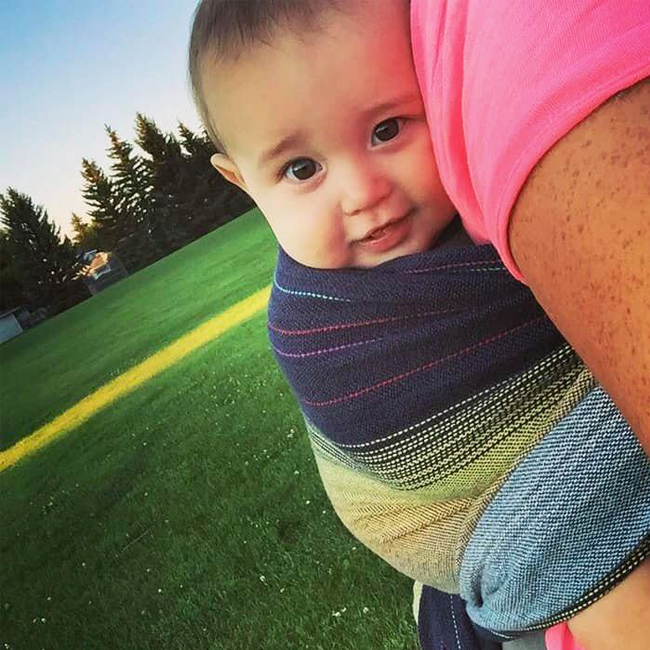
Do you have a favourite carrier or ones you suggest to caregivers?
I love all carriers, honestly. They each have their time to shine, depending on the age of baby, or one’s lifestyle, or event circumstances! Woven wraps are my personal favourite, because they are SO versatile and you can literally do anything with them and they also are the perfect fit every time, but there’s definitely more of a learning curve & they take some good practice.
If you’re looking for something a bit more user-friendly, then SSC’s (soft-structured carriers) are the way to go. Just be mindful when you’re purchasing one, and look at the weight limits and ages. Finding an all-stages SSC, like the Tula Free to Grow or the Chimparoo Trek, are the most helpful – the panels can be adjusted as baby grows and they have built-in infant inserts and adjustable straps!
I will say that I am not a huge fan of stretchy wraps – mostly because they don’t last long. Eventually baby gets too big and parents feel discouraged, because they don’t feel like they’re doing it right, but that’s just because it’s stretchy! They are a great little gateway to wrapping though, but if someone is working with a budget, I usually say skip it, and go to a woven.
What’s your opinion on a structured carrier versus a soft, flexible carrier?
I suppose I kind of answered that, but honestly, it’s more personal preference than anything else. My biggest thing is making sure you find something that is comfortable for both the baby and the wearer, and something you are motivated to wear!
Woven wraps are great for newborns and comfortable for parenting/cuddling, they are the most versatile, but take the most practice. Soft Structured Carriers are awesome for Dad’s, for up & down toddlers, and back carrying, especially over sweaters and bulkier clothing. Ringslings are the best for quick in and out’s, running into the store, doctors offices, etc.
Do you have any tips for making a ring sling stay in place nicely?
Ring slings are my jam!! I used to HATE them, but if you don’t have a good one, or if you don’t know how to use it correctly, they really do suck, and they can even hurt you! Finding a fabric that glides through the rings relatively well is important, but also something that has enough grip that it holds when secured. Finding a woven fabric with a little linen or texture to it can be helpful, or a handwoven-made ring sling too. Also, brand new carriers take time to break in, like a new pair of shoes, so they get better with wear and sometimes it just takes a little time! Understanding the leverage system of a sling is also very important – where your top rail is, bottom rail, and where to pull. Another little trick is barely touching the bottom rail in general, we need that extra fabric to support baby’s bum. It’s such a fine art! Here’s an old video I recorded, because it’s easier to explain visually.
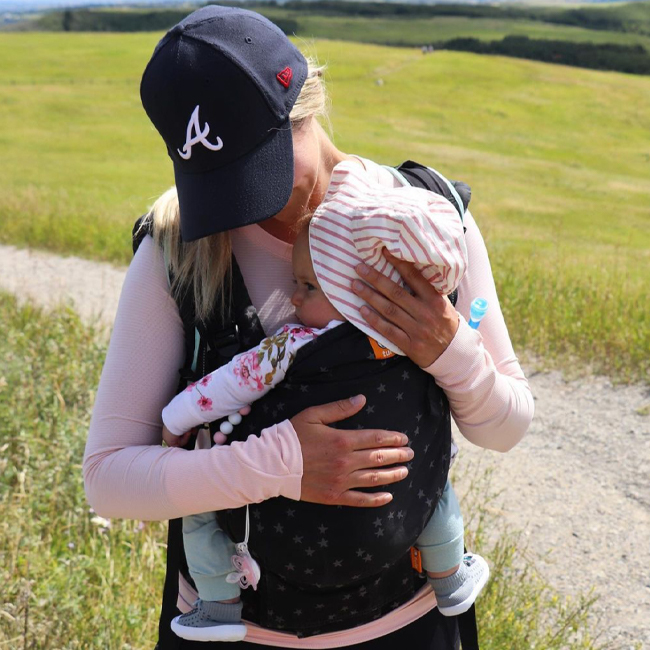
Is there a time limit per day for babywearing?
Nope! Not really. Honestly, follow your baby and your body. Babies are really smart and they’ll tell us when they have had enough, and so will your body. I can honestly say that I probably have never worn a kiddo for longer than 2 hours or so at a time. Someone needs to eat in there at some point!
How do you know you have baby in a safe position? Can you talk a bit about hip dysplasia?
Here are my safety rules of babywearing:
1. Kissable height – baby should be high and snug.
2. Upright and trunk fully supported – no cradle carry or laying down in the carrier.
3. Open airway – chin away from chest, 1-2 finger rule.
4. Legs in the shape of the letter “M” – knees above hips, carrier supporting bottomside of legs, from knee-to-knee.
5. Check integrity of carrier – make sure everything is safe, read the safety instructions/guidelines for your carrier.
6. Circulation – finger wiggle rule. Make sure the carrier is snug, not too tight cutting off circulation behind babies knees.
If you’re doing all of these things, you’re good! And my other rule of thumb is – if it doesn’t feel right, it probably isn’t. Lastly, ALWAYS check your work! And keep checking it, and checking in with baby while you’re wearing 🙂
When it comes to the hip dysplasia conversation, pretty much all of it has been debunked. HD has a strong genetic component and is something a baby is most often born with and not really acquired over time, although there is some evidence that holding a baby can affect hip development (ages 0-6 months) with a baby who has a predisposition of HD, if you are holding that baby a LOT of hours in a day, which honestly really isn’t that realistic. Ensuring your baby has their legs in that M position and is fully supported is the most important thing you can do. In fact, some doctors will actually encourage proper use of babywearing to help babies open their hips with this condition – always check with your Health Care Provider if your infant is showing signs or symptoms of hip dysplasia and you have concerns.
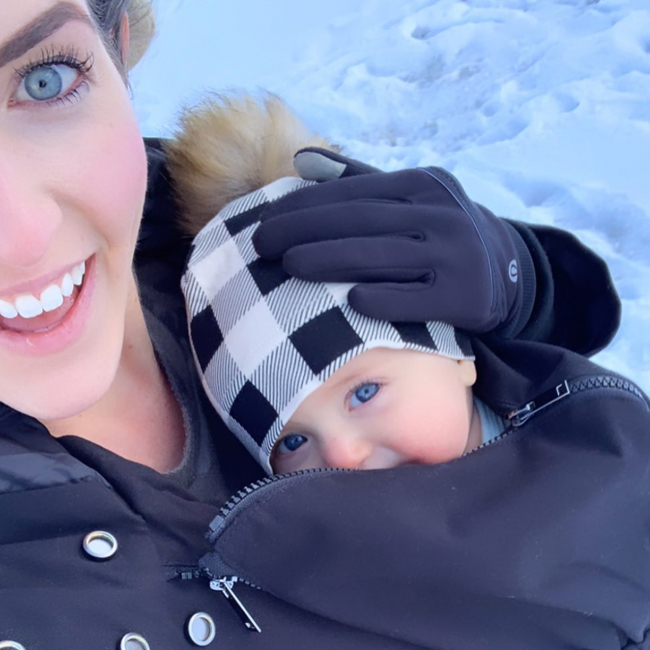
How should you and baby dress while babywearing outside in winter? Any quick tips for checking if baby is a good temperature?
Layers, layers, layers! Wool is a great natural fibre that helps insulate and keep baby warm, while wicking moisture and keeping durable! Because you are transferring body heat when wearing, you don’t have to over dress baby too much. Little wool socks, slippers, or leg warmers are awesome for babywearing too! Fun fact – the most accurate place to take a baby’s temperature by touch is the back of their neck, so if you’re not sure if they’re too warm or too cold, touch the back of their neck to check in!
Do you have any suggestions for baby wearing two kids (twins, for example)?
I personally don’t have a ton of experience babywearing twins, but I’ve taught a few handfuls of clients that have! Honestly, the majority of the feedback I get is that it’s not that much different from singleton wearing. It’s not very often that you can or will wear them at the same time. More often the parents each take one, or you wear one at a time. Ringslings tend to be the favourite, along with woven wraps, and for the proper age, the TwinGo carriers!
What if a child doesn’t seem to like being worn? Any suggestions? Should you start babywearing by the time they are a certain age in order to get them used to it?
Each kiddo has their own personality, and some genuinely don’t like to be worn, but I would say the majority do! I find if I have a protester, it usually has to do with a position thing – for example, they’re too big and ready to move to a back carry now, or shifting them more into a hip carry might change their view point better! Sometimes it’s a user-issue and the wearer needs to hone up their skills, because baby isn’t comfortable, but if everything is check-marked off and baby still protests, then I often suggest checking in with someone who does body-work on kids like a Chiropractor, RMT, or Physiotherapist. Sometimes babies get little kinks in their necks, or tension in their backs, and need some muscle release, and the carrier is aggravating it! Honestly, the sooner you can get into babywearing, the better! It’s just another parenting tool and a lovely little comfort measure for everyone!
Are there any other babywearing products you suggest?
Not really! I’m pretty simple when it comes to babywearing. Mostly because I think of different cultures around our world who have been doing this for centuries – in Africa for example, they wrap their babies in towels! It’s a pretty basic thing! There’s tons of different brands and styles out there. My advice would be to go beyond the basic franchise baby stores and check out other local shops or local groups on Facebook, etc. In Edmonton, we have a store called Two Mothers, which is a great local resource! There are SO many different types of carriers out there and they aren’t always on the shelves at the big-box stores.
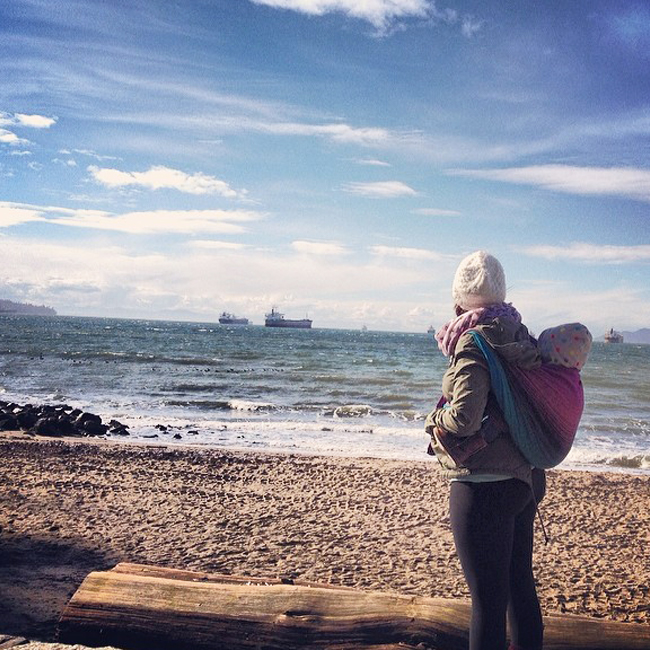
Do you hike or work with families who hike – do you have any tips for hiking with babies and toddlers, and baby wearing or having them in a hiking carrier?
When I’ve hiked, I’ve done smaller trails and kept it always to a woven wrap, so I personally haven’t used a big hiking carrier for a long time, other than trying it on. Basically, the same rules are going to apply, following the safety guidelines specific to the carrier and checking in with baby a lot. Depending on the weather or terrain of where you’re hiking, make sure you have good shoes, stay hydrated, and take breaks as needed. You can also check out – Hike it Baby – and search your community for local groups and hikes!
Can you talk a little about wearing toddlers or older kids?
As I mentioned above, soft-structured carriers is where it’s at for these kiddos. Toddlers are usually on the move, up and down, or adults are just wearing them for quick in and outs. Make sure your SSC has a panel large enough to support your toddler (you can purchase toddler-sized carriers). I always joke that babywearing toddlers becomes a little less about bonding and a bit more about entrapment, haha! No joke though, sometimes getting them on your back is what’s keeping them from falling into a fire or running in a parking lot! Honestly, my family used it a lot to not only keep them safe, but also to help them self-regulate. Kids get overstimulated sometimes, especially during the toddler years, and babywearing can become this little safety/weighted blanket-type thing that can genuinely save everyone’s sanity!
Do you have any advice for having a strong core in order to baby wear? Any other suggestions for keeping the grownup from becoming sore?
This is SUCH an important question! Especially with newly postpartum Moms, and depending on how the birth went and recovery is going. For brand new moms – go slow!!! Wean onto wearing – do it for 20 minutes at a time and build up slowly. Pay attention to your posture and how you tilt your pelvis or swing your hips forward to support baby on your front. Watch your shoulders, and remember to bring them back, keeping yourself tall. I’m a huge advocate for every woman (birther or not) seeing a Pelvic Floor Physiotherapist, especially postpartum. We are trying to heal your pelvic floor and not add more dynamics to it. I think core-muscle strengthening is important, but really building the body as a whole is essential. Your glutes (bum) muscles, pecs, and shoulders play a huge role in this too, so lots of movement in general to build strength will help, but the most important thing is to STRETCH! Just like you would after going on a long hike, if you wore your baby on your back for an hour, walking up and down the stairs doing 4 loads of laundry for an hour – stretch afterwards! Because trust me, you can actually be sore from babywearing. Self-care is important! Lots of water too!
Is there anything else you want to share?
Check out your local online communities for tips and support, or Babywearing Educators! There’s a lot of like-minded parents who are also learning, and we learn best when we learn together! Youtube and Instagram have some fantastic videos and resources. Do some digging and keep practicing! It’s so worth it in the end!
Where can people find you and follow along with all your endeavours helping birthing and postpartum women?
You can check me out on Instagram or Facebook or my doula crew website. Locally, I will be working at Pine Integrated Health for Massage Therapy!
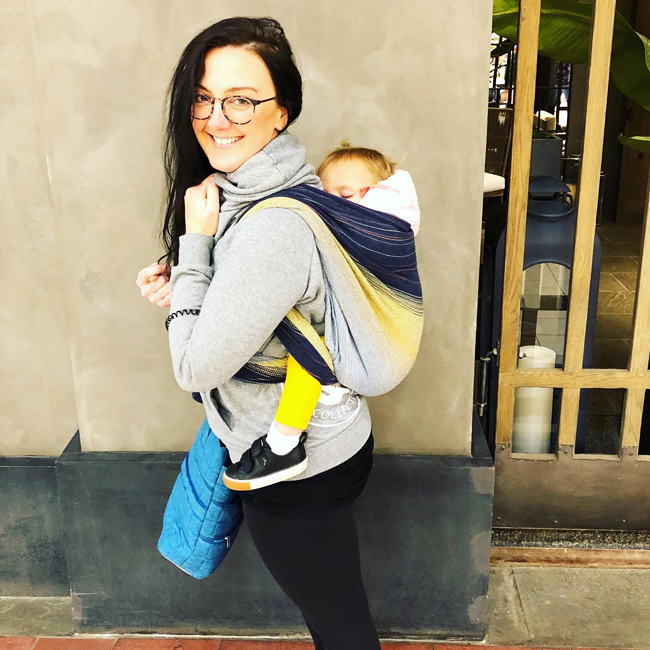
Wow, that’s a lot of amazing material to take in! Hope you all took something away from all of Vanessa’s knowledge and you get some baby (or toddler) snuggles in very soon!!
